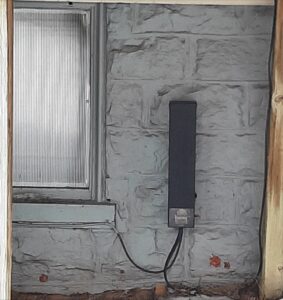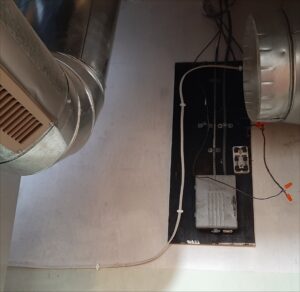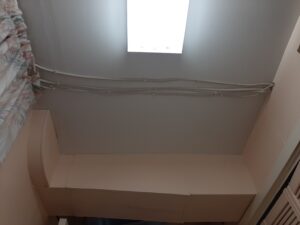As all of us that have worked on an old house knows, sometimes when you start a small repair you find there are more things behind that repair that tend to make it a larger project. This is true at the church as well.
Now that we have the ramp lights working again, it has become clear that one of the reasons these didn’t last as well as was hoped is because the photocell that was supposed to control turning off the lights when the sun is up is not working as planned. This cell is located under the steps in the black box near the basement window as seen in the picture below. This location is too dark/shadowed so the lights will come on in just overcast or cloudy conditions during the day. Also, this timer is the old motor and gear type and has been running now continuously for 20+ years so isn’t as accurate of a timekeeper as it once was. The net result of this is that if we want to continue to operate these lights for an hour each day at sunset, someone has to manually go to the church and adjust the timer as the days lengthen or shorten on a fairly regular basis.

Also, as seen in the other attached pictures, the high voltage (120v) wiring that feeds this circuit doesn’t meet any type of best practices for safe, long-term installation. Stapling regular Romex wire to sheetrock is just wrong in so many ways….. sheetrock doesn’t hold nails well, the wire is low enough for the insulation to be accidentally nicked and create a shock or even electrocution hazard, it could be painted and chemicals in the paint could cause an insulation failure, etc. This is a textbook example of an accident waiting to happen.


With all of the above liability mind, we are looking to fix this circuit and bring it up to current National Electric Code (NEC) standards. Tim G has agreed to help us with a few changes.
1. We plan to move the timer indoors into the furnace room so trustees don’t have to climb through a snowbank to set it this time of year, or stand in the cat litter box that the sand under the steps becomes in the summer.
2. We plan to replace the existing simple 24-hour timer with a new 7 day digital astronomic timer. An astronomic timer automatically adjusts to the sunrise and sunset so if you set it for one hour after dusk, it changes that hour as needed between December and June without having to constantly adjust manually. Because it’s 7 days, we could set a different schedule for Wednesday Lent services vs Sunday morning services when needed. The device we are looking at is this one:
https://www.amazon.com/Honeywell-PLS750C1000-Ti072-3W-Sunrise-Required/dp/B004ZFNL16?th=1
It’s a decent brand name, not really that expensive, and no battery in this one to maintain like many Chinese brands have.
3. We plan to rework the existing backboard on the wall in the furnace room to mount the new timer to. This would mean removal of the old, unused switch box, creating a cleaner installation of the dangling furnace thermostat wires, installing a board lower to mount the new timer on at something closer to eye level for the trustees, and just a general fix-up of this sloppy work.
4. We plan to remove the wires running below the ceiling in the hallway and re-route them properly above the ceiling so we don’t have exposed romex stapled to sheetrock which is both ugly and unsafe. We think this is possible without tearing out the wall board.
5. We plan to bring just the circuit feeding the ramp lights up to existing NEC standards and install an outlet in the Furnace room below the new cleaned up backboard. There are no outlets in this room currently and best practices (and code) would require at least one so that someone working on the furnace could power off the furnace but still have a working outlet for a trouble light or other tools in that room. Because the ramp lights are a separate circuit and now take so much less power, we should have the capacity for this outlet without requiring an additional breaker.
Please Note:
We are aware there is a lot more in the furnace room (and elsewhere) that should be done to be up to current NEC best practices and standards, but the above is just a good place to start without getting pulled into a major electrical project. We’ll try to eat this elephant one small bite at a time as funds allow, and this is just the first small bite.
The timer was ordered this last week and although everyone who is involved in this has a pretty busy schedule, we intend to have the above work done by Easter, time and weather permitting.
As always, we welcome your insights, comments and suggestions.
Thanks!
David